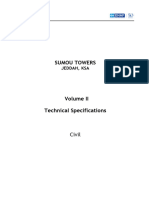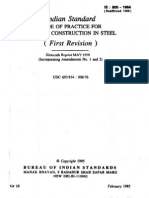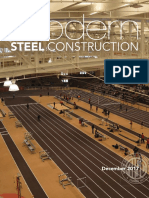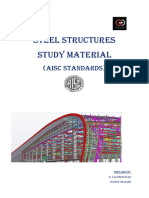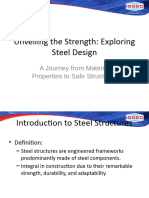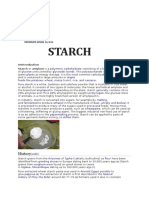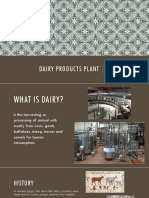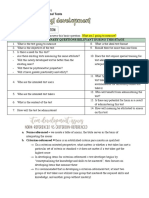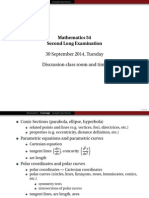Interview ques ons
1)What is the difference between dead load and live load in structural engineering?
Answer: Dead load refers to the sta c, permanent weight of a structure and its components, such
as the weight of the building itself and fixed elements like walls and floors. Live load, on the other
hand, is the dynamic and variable load imposed on a structure, like people, furniture, and
temporary loads. Dead load is always present, while live load varies.
2)Describe the difference between concrete and steel as structural materials. What are the
advantages and disadvantages of each?
Answer: Concrete is a bri le material with high compressive strength but rela vely low tensile
strength. Steel, on the other hand, has high tensile strength and duc lity. Concrete is more cost-
effec ve and suitable for compression, while steel is used in tension and bending. Combining both
materials (reinforced concrete) leverages their strengths while mi ga ng weaknesses.
3)What is the difference between S235 AND SPHC,
S235 is part of the European standard EN 10025 for structural steel.
S235 steel grades are commonly used for structural applica ons, such as building construc on,
bridges, and general structural engineering.
The numbers (e.g., S235JR, S235J2, S235J0) indicate different varia ons of S235 with specific
proper es.
S235 typically has a minimum yield strength of 235 MPa, which makes it a low to moderately high-
strength structural steel.
SPHC stands for Steel Plate Hardness Commercial, and it is a designa on used in the Japanese
Industrial Standard (JIS) G 3131.
SPHC refers to a specific type of hot-rolled steel sheet, o en used for forming and deep drawing
applica ons, such as in the automo ve industry.
It is typically a low-carbon steel with good formability and is suitable for processes like stamping,
bending, and welding
4)Explain the principles and challenges of designing long-span roof structures, such as those for
sports stadiums or airport terminals.
Answer: Challenges include deflec on control, wind loads, and aesthe c requirements. To address
these, engineers use advanced structural analysis, wind tunnel tes ng, and materials like high-
strength steel or composite materials to achieve both structural performance and architectural
intent.
�5)How do you calculate deflec ons in structural members subjected to various loads, and what
methods or formulas are typically used for determining deflec on limits?
Answer: Deflec ons can be calculated using methods like double-integra on for concentrated
loads, Macaulay's method for distributed loads, and the moment-area method for slopes and
deflec ons at specific points. Deflec on limits are typically specified in building codes or
standards, and engineers ensure that they are not exceeded to meet serviceability requirements.
6)What is sa y factors and how you calculate the sa y factors?
he safety factor is typically expressed as a ra o, calculated as follows:
Safety Factor (FoS) = Ul mate Load or Capacity / Design Load or Requirement
The "Ul mate Load" represents the maximum load or force a structure or component can
withstand without failing.
The "Design Load" refers to the expected or specified load under normal condi ons.
7)How can you apply QA/QC in structural steel?
Quality Control Plan (QCP)
Develop a comprehensive Quality Control Plan that outlines the procedures, responsibili es, and
quality standards for each phase of the project, from material procurement to fabrica on, welding,
and erec on.
Cer fica on and Compliance:
Ensure that all materials and processes meet the required cer fica ons, standards, and codes,
such as ASTM, AISC, AWS, and local building codes.
Material Inspec on:
Verify the quality and conformity of steel materials, including checking for the correct grade, size,
and compliance with specifica ons. This includes inspec ng steel plates, beams, columns, and
fasteners.
Welding and Fabrica on:
Monitor and inspect welding and fabrica on processes to ensure that welders are qualified,
welding procedures are followed, and welds are sound and meet specified standards. This includes
non-destruc ve tes ng (NDT) methods like ultrasonic tes ng, magne c par cle tes ng, and
radiography.
Pain ng and Coa ng:
Ensure that any required protec ve coa ngs, such as paint or galvaniza on, are applied correctly
and meet the specified thickness and quality standards.
�Erec on and Installa on:
Supervise the erec on and installa on process to confirm that components are posi oned
accurately, bolts are ghtened properly, and that safety procedures are followed.
Quality Audits:
Conduct regular quality audits and inspec ons at various stages of the project to iden fy and
address any devia ons from the Quality Control Plan.
Documenta on and Records:
Maintain detailed records of all quality control and inspec on ac vi es, including material test
reports, welding logs, inspec on reports, and cer fica ons.
Third-Party Inspec ons:
Consider involving third-party inspec on and tes ng agencies to provide independent verifica on
of quality and compliance with standards. Their exper se and neutrality can be valuable in
ensuring quality.
Training and Cer fica on:
Ensure that all personnel involved in the steel construc on process, including welders, inspectors,
and quality control personnel, are trained and cer fied as per industry standards.
Traceability and Labeling:
Implement traceability systems to track the origin and processing of steel materials, and label
components with unique iden fiers to maintain accountability.
Documented Procedures:
Document all procedures, inspec ons, and tes ng processes in a clear and organized manner. This
documenta on is essen al for project records and future reference.
Communica on:
Foster open communica on among project stakeholders, including engineers, fabricators, erectors,
and inspectors. Address any issues or non-conformi es promptly.
Con nuous Improvement:
Encourage a culture of con nuous improvement, where lessons learned from previous projects are
used to enhance future quality control procedures.
Adherence to Standards:
Ensure that all ac vi es conform to industry standards, including those set by organiza ons like
the American Ins tute of Steel Construc on (AISC) and the American Welding Society (AWS).







